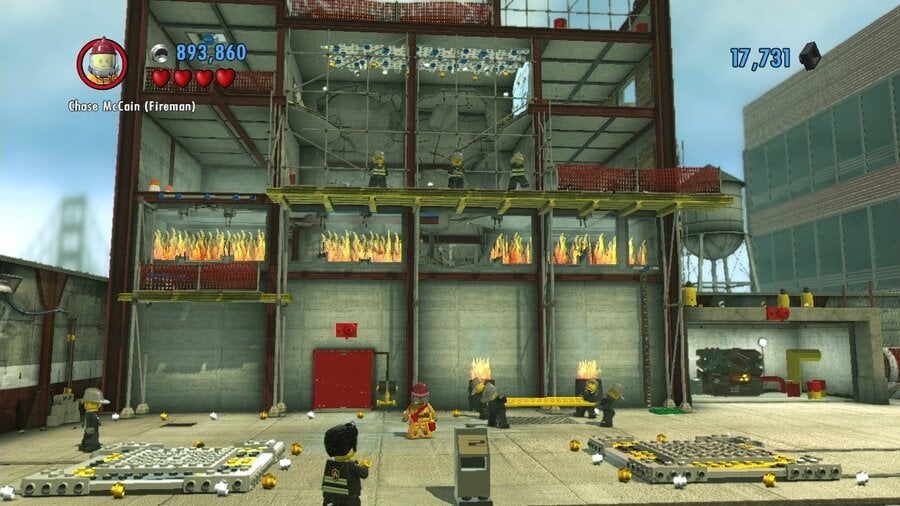
We recently had the opportunity to spend a day at TT Fusion games in Wilmslow, England, to learn more about LEGO City: Undercover and have an extensive play-through on a close-to-final build. You can check out our first impressions of LEGO City: Undercover here, but our day at the studio also included an interview with four key members of the development team: executive producer Loz Doyle, script writer Graham Goring, lead designer Lee Barber and LEGO lead Stephen Bate.
During our interview the team gave some details on the scale of the world that you inhabit in this title, as well as the broad range of collectibles that can be found hidden throughout the city or, perhaps, through repeated plays on story missions in Free Play. Distractions will commonly take you off the story mission path — we can attest to this — and when discussing DLC, Loz Doyle didn't rule it out while saying the following:
There are so many vehicles, characters and missions. There’s so much content in the game already – you’re talking 40-50 hours to get 100%, it’s difficult to imagine what we could put in. We wouldn’t rule it out, but it’d have to be the right thing to fit with the rest of the game.
...Initially in the San Francisco area at the start of the game you’re really focused on the story, but as you get more abilities you’ll see things that had locked icons before that you couldn’t use, and now you can. That’ll encourage you to explore and use those different game mechanics and abilities.
Another area that the team addressed was the importance of Wii U as a platform in driving how the game was put together, with the title very much focused on delivering on the unique selling points of Nintendo's console. Praise was reserved for the amount of on-board memory in particular, while the GamePad was described as absolutely key to the final experience.
Lee Barber: I don’t think for LEGO City we could do it without the GamePad, it’s pretty much central and a core element of the game. This is for both the character in the game and the player; what you see the character doing, the player can do as well, so they’re linked by the same device. As the character in the game upgrades, so do the player’s abilities to do the same. It’s not just limited to a map of a city, the player can feel like a detective or like they’re locating a robber, or locating a hidden item. We feel that’s pretty unique.
...Graham Goring: It’s one of the weird things. We’re developing on PC and there’d be things you’d do if you didn’t have a dev kit, but it wouldn’t have the life. For example with the audio scanning you’d just be using a thumbstick, but you’d do it on the GamePad and it’d feel great, like a revelation. That complete feedback, a window into the world, feels different and fresh. You could do some of the features on a standard controller, but it’d be a shadow of itself.
It’s just the fact that you’ve got a screen in your hand that responds to your positioning, it’s wonderful.
We covered a lot of ground with the team in our interview, so check back later today for the full article.
In the meantime, what do you think of these comments? Is this game on your radar ahead of its release in March? Let us know in the comments below.





Comments 14
really looking forward to this.
It's looking really nice
Don't forget that there's already one DLC (kinda). If you buy one of the LEGO City playsets you get a code for more vehicles (probably the ones in the set) and mission(s).
I'm extremely pumped for this game Can't wait to explore the world in a month, it's going to be awesome
This is going to be my payday purchase. Shame there's no co-op or assist aspect, but I think it's one of these games that both myself and my daughter will be playing whilst the other one watches regardless!
Oh man I need to buy all these games in march... hahaha
Whoa that is a lot of time! Can't wait for it to come out! I love LEGO!
Doesn't surprise me. When I was younger, I spent easily that much time on Lego Star Wars The Complete Saga.
I'm excited for this. I only played maybe 2 of the Lego games and I thought they were ok, but this game looks to take up a few levels.
More reasons to buy this game.
Of course it is... I've already preordered it to get limited edition.
I'm really looking forward to this, it better not disappoint when the reviews start coming in.
Pre-ordered my copy. Not sure why it's listed for only $49.99, but I'm not complaining
Can't wait for this game Day one purchase for sure! Can't wait to have something to play with my Fancy Wii U I love it but it isn't getting much playtime right now... But frankly i'm not playing games at all right now... So yeah
Tap here to load 14 comments
Leave A Comment
Hold on there, you need to login to post a comment...